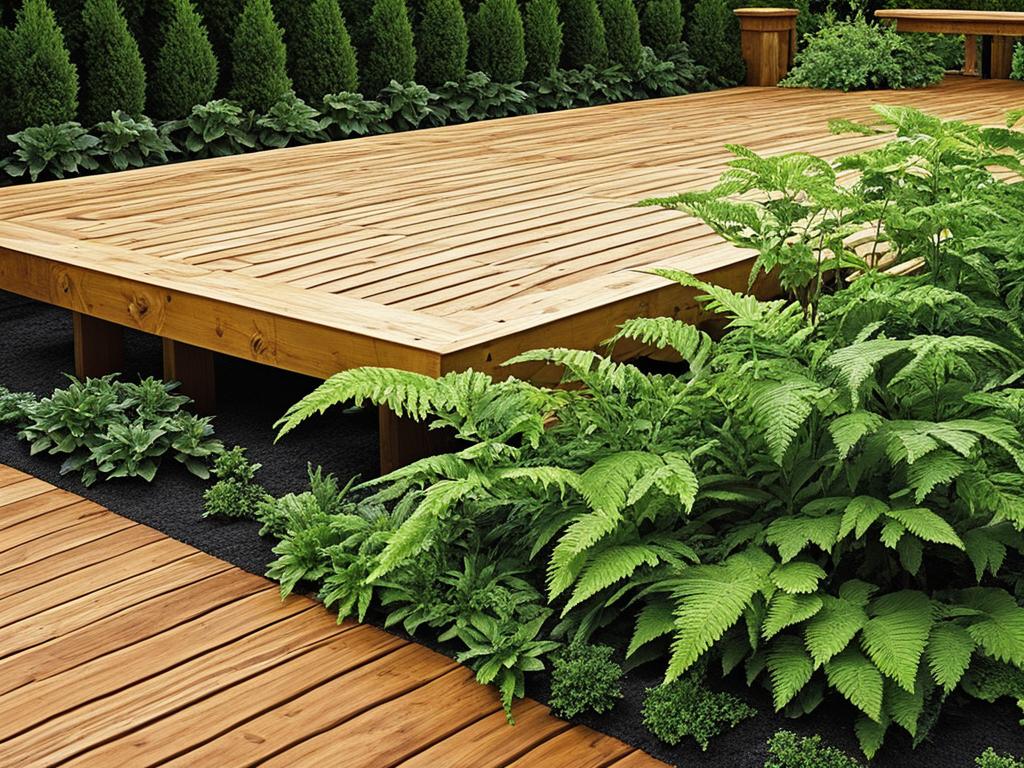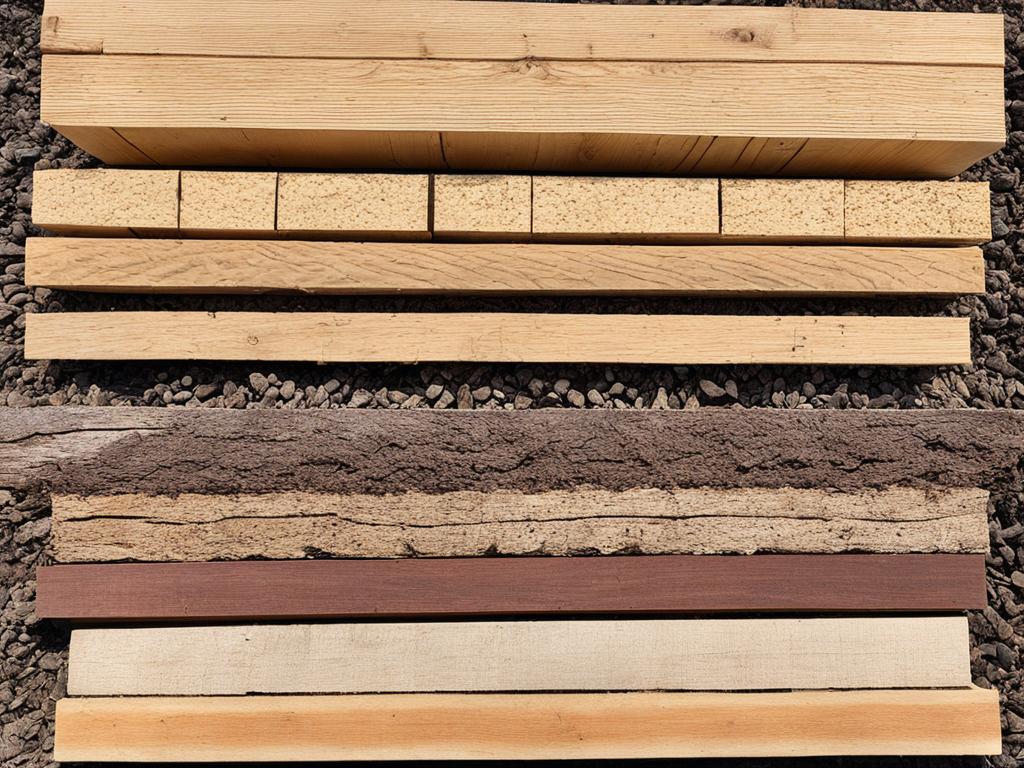Are you planning an outdoor project and trying to decide which type of lumber to use? When it comes to choosing between ground contact lumber and pressure treated lumber, it’s essential to understand the differences and benefits of each. Let’s dive into the details to help you make an informed decision.
Key Takeaways:
- Ground contact lumber is specifically designed to withstand being close to or in contact with the ground.
- Pressure treated lumber is treated with chemicals to resist rot, decay, and termites.
- Ground contact lumber is ideal for projects exposed to all types of weather or with a high potential for decay.
- Pressure treated lumber is versatile and commonly used in heavy construction, as well as residential and outdoor projects.
- Consider the specific requirements of your project when choosing between the two types of lumber.
Benefits of Ground Contact Lumber
When it comes to outdoor projects, ground contact lumber offers a variety of significant benefits. Its unique properties make it an excellent choice for projects that require durability, resistance to rot and decay, and protection against termites.
- Wood Longevity: Ground contact lumber has a high chemical retention level, which provides superior protection against rot, decay, and termites. This enhanced resistance helps extend the longevity of projects made with ground contact lumber, ensuring they stand the test of time.
- Protection against Rot and Decay: Ground contact lumber is specifically designed to withstand continuous moisture and direct contact with the ground. This inherent resistance makes it highly effective in projects exposed to all types of weather conditions and with a high potential for decay.
- Resistance to Termites: In addition to protecting against rot and decay, ground contact lumber is also highly resistant to termites. This makes it an ideal choice for outdoor projects where termite damage can be a significant concern.
- Outdoor Durability: Ground contact lumber’s ability to withstand environmental factors and pests makes it highly durable for outdoor use. Whether it’s used for decks, fences, garden beds, or any other outdoor application, ground contact lumber is engineered to withstand the elements and maintain its integrity over time.
To showcase the benefits of ground contact lumber, refer to the table below:

| Benefits | Ground Contact Lumber | Other Lumber Types |
|---|---|---|
| Wood Longevity | ✔️ | ❌ |
| Protection against Rot and Decay | ✔️ | ❌ |
| Resistance to Termites | ✔️ | ❌ |
| Outdoor Durability | ✔️ | ❌ |
Benefits of Pressure Treated Lumber
Pressure treated lumber offers numerous benefits for your outdoor projects. Its durability and high-quality make it an ideal choice for a wide range of applications. The wood is treated with chemicals to resist rot, decay, and termites, enhancing its longevity and ensuring it can withstand the elements.
One of the key advantages of pressure treated lumber is its exceptional durability. It can withstand heavy use and exposure to harsh weather conditions, making it suitable for various outdoor structures and constructions.
With its resistance to rot and decay, pressure treated lumber is an excellent option for projects in damp or humid environments. It is particularly effective for applications that involve direct contact with moisture sources, such as posts, beams, retaining walls, or lumber touching concrete or masonry work.
Furthermore, pressure treated lumber provides excellent protection against termites. The chemical treatment acts as a deterrent, reducing the risk of termite damage and extending the lifespan of your outdoor projects.
Another notable benefit of pressure treated lumber is its versatility. It is widely used in heavy construction projects, including bridges, guardrails, and docks. Additionally, it is a popular choice for residential applications such as decks, fences, and building structures.
Recommended Applications
Pressure treated lumber is recommended for a variety of outdoor projects, including:
- Decks
- Fences
- Docks
- Retaining walls
- Building structures
- Posts and beams

Conclusion
When it comes to outdoor projects, choosing the right lumber is crucial for long-lasting durability, resistance to rot and decay, and protection against termites. Ground contact lumber and pressure treated lumber are two popular options, each with its own benefits.
Ground contact lumber is specifically designed to withstand the effects of being in direct contact with the ground. It offers enhanced resistance to rot, decay, and termites, making it an excellent choice for projects exposed to all types of weather or with a high potential for decay.
On the other hand, pressure treated lumber is treated with chemicals, providing durability and versatility. It is highly resistant to rot, decay, and termites, making it suitable for a wide range of applications, including heavy construction and residential projects.
When deciding between ground contact lumber and pressure treated lumber, consider the specific requirements of your project. If your project will be in constant contact with the ground, exposed to harsh weather conditions, or has a high potential for decay, ground contact lumber may be the best choice. For versatile applications and long-term durability, pressure treated lumber is a reliable option.
FAQ
What is the difference between ground contact lumber and pressure treated lumber?
Ground contact lumber is specifically designed to withstand the effects of being close to or in contact with the ground, while pressure treated lumber is treated with chemicals to resist rot, decay, and termites.
What are the benefits of ground contact lumber for outdoor projects?
Ground contact lumber has a high chemical retention level, providing better protection against rot, decay, and termites. It is designed to withstand continuous moisture and direct contact with the ground, making it ideal for projects exposed to all types of weather conditions and with a high potential for decay.
What are the benefits of pressure treated lumber for outdoor projects?
Pressure treated lumber is durable and high-quality, making it ideal for a wide range of applications. It is treated with chemicals to resist rot, decay, and termites, enhancing its durability and longevity. It is versatile and commonly used in heavy construction as well as residential and outdoor projects.
How do I choose between ground contact lumber and pressure treated lumber for my outdoor project?
Consider the specific requirements of your project. Ground contact lumber is recommended for projects exposed to all types of weather or with a high potential for decay, while pressure treated lumber is versatile and commonly used in various applications. Choose the lumber that best meets your project’s needs in terms of durability, resistance to rot and decay, and protection against termites.
